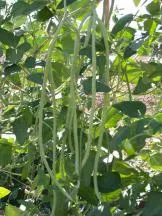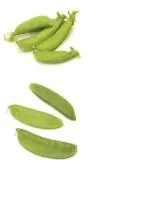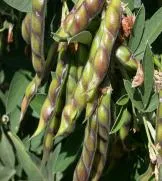
Chinese long beans - (Vigna sesquipedalis): Also called the asparagus bean and yardlong bean, the plants are long training vines grown on trellises. The plants are susceptible to black bean aphids, spider mites, nematodes, and mosaic viruses. The plant is more closely related to blackeye peas than to the common green snap bean. Dark and light green varieties are available as well as a red type. The darker varieties are generally preferred. Trellised. Warm season.
Cut into 2" pieces and add to various stir-fries. The paler green is sweeter and more tender than the dark green.

Snap pea (top) and Snow pea (bottom) - (Pisum sativum): This is the only cool season member of the group. It deteriorates quickly in the heat of summer. The plants are trellised to facilitate the picking, however, if grown for the tender shoot tips, they are usually left untrellised. Problems encountered in Fresno include thrips, aphids, caterpillars, and a devastating fungal disease called Ascochyta.
The pods and seeds are edible and are essential in oriental dishes. They are used in soups, beef and other meat dishes, stir-fry, and sukiyaki. Snow peas are flat and should be trimmed at both ends. Snap peas are more filled out and do not require trimming. Stir-fry in sesame oil for 2-3 minutes and toss with a bit of soy sauce. The tender tips can be boiled like spinach or added fresh to a green salad for a special treat.

Hyacinth bean - (Lablab niger): is a vigorous twining vine. Lablab is an Arabic or Egyptian name describing the rattle of the seeds in the dry pod. Pods are oblong and flattened. The most popular strains have purple tinting at the margins. It is native to India. Warm season.
The fresh immature pods cannot be eaten raw because they contain a poisonous glycoside that is destroyed when they are boiled.
